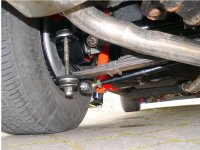I'm working on the rear suspension at the moment and whilst access if good I'm just making sure that everything is ok before the body goes back on. I have a question about the movement of the rear road wheels relative to the differential and the stress it puts on the diff and/or half shafts. I've been thinking about it for a while and my head is starting to hurt so perhaps someone can help put me straight ..... Here's my question....
The differential is effectively fixed to the body via the cross member.
When a rear road wheel hits a bump, the half shaft and strut move around fixed points on the differential and the strut mounting underneath.
The trailing arm rotates around its spindle at the forward end and the spindle is mounted in a bush on the trailing arm.
When going over humps or bumps, the road wheel goes up and down in the vertical plane, controlled by the trailing arm.
When a bump is hit, the road wheel goes up and down vertically (and as it swings around the spindle, the wheel centre presumably moves back a bit too), the half shaft and the strut rod rotate around the differential and thus the distance between the diff and the road wheel changes, the distance being at a maximum when the half shaft is at 90 degrees to the diff. The diff is fixed and thus something has to give to accommodate the changing distance between the diff and the road wheel, otherwise there will be a massive stress on the half shaft, the trailing arm or the components in the differential. Is this correct?
The only compliance in the arrangement is in the training arm spindle bush and the bushes on each end of the strut, so when going over a bump does the trailing arm twist on the spindle (and/or move outward) resulting in the camber of the wheel changing?
The differential is effectively fixed to the body via the cross member.
When a rear road wheel hits a bump, the half shaft and strut move around fixed points on the differential and the strut mounting underneath.
The trailing arm rotates around its spindle at the forward end and the spindle is mounted in a bush on the trailing arm.
When going over humps or bumps, the road wheel goes up and down in the vertical plane, controlled by the trailing arm.
When a bump is hit, the road wheel goes up and down vertically (and as it swings around the spindle, the wheel centre presumably moves back a bit too), the half shaft and the strut rod rotate around the differential and thus the distance between the diff and the road wheel changes, the distance being at a maximum when the half shaft is at 90 degrees to the diff. The diff is fixed and thus something has to give to accommodate the changing distance between the diff and the road wheel, otherwise there will be a massive stress on the half shaft, the trailing arm or the components in the differential. Is this correct?
The only compliance in the arrangement is in the training arm spindle bush and the bushes on each end of the strut, so when going over a bump does the trailing arm twist on the spindle (and/or move outward) resulting in the camber of the wheel changing?

